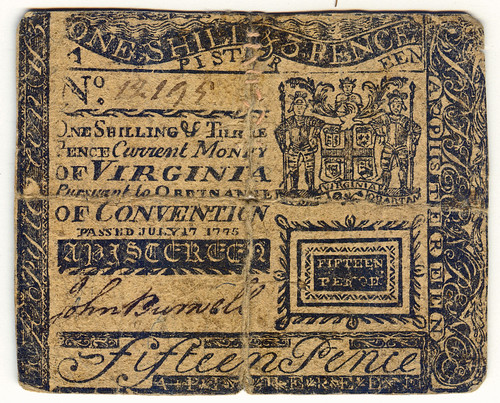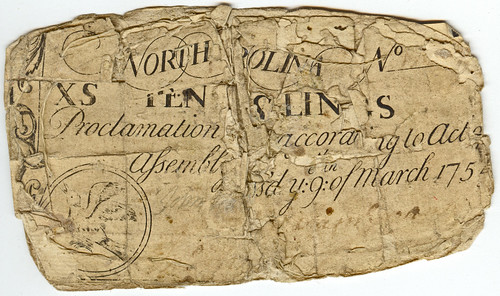
PREV ARTICLE
NEXT ARTICLE
FULL ISSUE
PREV FULL ISSUE
V11 2008 INDEX
E-SYLUM ARCHIVE
ARTICLE DISCUSSES "WORN, TORN & SOILED" U.S. COLONIAL PAPER MONEY
Erik Goldstein (Curator of Mechanical Arts and Numismatics
at the Colonial Williamsburg Foundation) and Joe Lasser (longtime
numismatist and donor to the collection) coauthored a neat article in the
September 2008 issue of The Numismatist on "Worn, Torn &
Soiled" U.S. colonial paper money. Erik's an E-Sylum subscriber and he
kindly provided the text and some images from the article - here are a
couple excerpts.
Note that I've not attempted to match up the illustrations with the text I selected. Lazy, I know - "Bad, Editor, Bad!" Slap me with a wet mouse cord if you must, but be sure to check out the complete article as published. -Editor
... there is also an
insistent series of reminders that paper money was the primary form of
cash in our colonial period. Eric Newman, on p. 13 of his The Early Paper
Money of America, points out that .On the eve of the American Revolution,
Alexander Hamilton estimated that the money supply in America consisted of
one-fourth specie and three-fourths paper money..Note that I've not attempted to match up the illustrations with the text I selected. Lazy, I know - "Bad, Editor, Bad!" Slap me with a wet mouse cord if you must, but be sure to check out the complete article as published. -Editor
Between 1690, when Massachusetts issued #7,000 of currency to pay for a military expedition against Canada, and 1789, when George Washington was chosen as our first President, over 100,000 different bills in many different denominations were issued to meet an extraordinarily wide arrange of financial needs. Because paper money was typically numbered by hand and often carried multiple signatures, even the most avid collectors are faced with an obviously impossible task of attempting to acquire well over half a million pieces if they with to assemble a collection with specimens carrying all known signature combinations.
Although a sizeable number of paper money authorizations were for what we would consider customary financial purposes, a number of emissions are a far cry from our concepts of typical. Georgia issued bills .for the encouragement of SETTLERS and rebuilding the COURT-HOUSE in Savannah.. Pennsylvania emitted bills to build jails, workhouses and poorhouses.
Because paper money was money, it was valuable and because it was valuable, it was repaired if it was torn. Common mending methods include repairs done with pins, glue, paper tape and sealing wax, newspaper, old letters, and those sewn with needle & thread! Even in shambles it moved from hand-to-hand, and in some Southern colonies, especially North Carolina, was customarily endorsed as it was transferred.

Examination of well circulated heavily repaired colonial notes provides intriguing glimpses into the contemporary thoughts, ideas and events current in our colonial society. The reverse of the illustrated heavily threaded stitched North Carolina five shillings April 4, 1748 note discloses that it is the remnants of a newspaper carrying marriage and death announcements plus giving the very odd hint of a reference to Guy Fawkes who attempted to blowup the British House of Parliament in 1605!!! Even more evocative is the Delaware, February 28, 1746 20 shillings note. It is backed by a page from a German language medical volume giving advice on when and how a person should be bled for health purposes.

Any reviews of colonial paper usage patterns also must include the typical practice of the endorsing of notes. Most commonly seen on North Carolina notes, the buyers or purchasers in commercial transactions signed their names on the reverses of the currency being paid to the seller of the product or services. With this safety net in place, should a note turn out to be counterfeit, it could be traced back to its scandalous source, in theory.
As a consequence, there are multiple endorsements on the reverse of many issues. Not only were North Carolina bills heavily endorsed when they were first put into circulation, some ultimately had to be backed and these repaired bills were then endorsed on the added backing. The illustrated #5 note of January 28, 1758 remained in circulation for more than fifteen years as indicted by the endorsement of Joseph Whitfield on December 3, 1773. Clearly, this piece of currency had been widely accepted for an extended period, despite its extensive use and obvious wear, when it could have been retired earlier and terminally shredded.
Today, many try to acquire only the best surviving examples, but it is readily apparent that worn, torn, heavily used specimens have intriguing historical stories to tell. Thus, they are so much more than simply worn out pieces of paper, and rightfully deserve not only attention and study, but inclusion in the holdings of those seeking to collect colonial America.s real paper money!
To view a slide show of colonial paper money images from the article, see: Williamsburg Colonial Paper Money (http://www.flickr.com/photos/coinbooks/sets/72157607235885286/show/)
Wayne Homren, Editor
The Numismatic Bibliomania Society is a non-profit organization promoting numismatic literature. See our web site at coinbooks.org.
To submit items for publication in The E-Sylum, write to the Editor at this address: whomren@gmail.com
To subscribe go to: https://my.binhost.com/lists/listinfo/esylum
All Rights Reserved.
NBS Home Page
Contact the NBS webmaster
